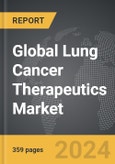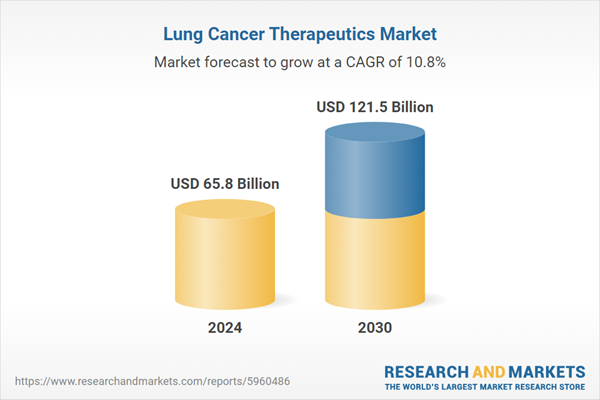The global market for Lung Cancer Therapeutics was valued at US$65.8 Billion in 2024 and is projected to reach US$121.5 Billion by 2030, growing at a CAGR of 10.8% from 2024 to 2030. This comprehensive report provides an in-depth analysis of market trends, drivers, and forecasts, helping you make informed business decisions. The report includes the most recent global tariff developments and how they impact the Lung Cancer Therapeutics market.
Segments: Type (Non-Small-Cell Lung Cancer (NSCLC), Small-Cell Lung Cancer (SCLC)).
Geographic Regions/Countries: World; United States; Canada; Japan; China; Europe (France; Germany; Italy; United Kingdom; Spain; Russia; and Rest of Europe); Asia-Pacific (Australia; India; South Korea; and Rest of Asia-Pacific); Latin America (Argentina; Brazil; Mexico; and Rest of Latin America); Middle East (Iran; Israel; Saudi Arabia; United Arab Emirates; and Rest of Middle East); and Africa.
The analysts continuously track trade developments worldwide, drawing insights from leading global economists and over 200 industry and policy institutions, including think tanks, trade organizations, and national economic advisory bodies. This intelligence is integrated into forecasting models to provide timely, data-driven analysis of emerging risks and opportunities.
Global Lung Cancer Therapeutics Market - Key Trends & Drivers Summarized
What Are the Latest Innovations in Lung Cancer Treatment?
The treatment landscape for lung cancer has seen remarkable advancements, particularly with the development of targeted therapies and immunotherapies. Traditional chemotherapy, while still in use, is increasingly supplemented or replaced by treatments tailored to the genetic makeup of tumors. Targeted therapies, such as tyrosine kinase inhibitors (TKIs) like Erlotinib and ALK inhibitors like Crizotinib, focus on specific genetic mutations found in non-small cell lung cancer (NSCLC). Immunotherapies, including checkpoint inhibitors like Pembrolizumab and Nivolumab, have revolutionized treatment by harnessing the patient’s immune system to fight cancer. These therapies significantly improve survival rates and quality of life for patients, marking a shift towards more personalized and effective treatment strategies.How Are Combination Therapies Enhancing Patient Outcomes?
Combination therapies are becoming a cornerstone in lung cancer treatment, providing synergistic effects that enhance patient outcomes. Combining immunotherapy with chemotherapy has shown to extend survival in patients with advanced lung cancer. For instance, the combination of Pembrolizumab with chemotherapy has become a standard treatment for NSCLC. Additionally, combining targeted therapies can overcome resistance mechanisms that often develop with single-agent treatments. The integration of radiation therapy with systemic treatments also improves local control of the disease and reduces recurrence rates. These multifaceted treatment approaches aim to tackle the complexity of lung cancer, addressing different pathways and mechanisms involved in tumor growth and progression.Why Is Precision Medicine Crucial in Lung Cancer Therapeutics?
Precision medicine plays a pivotal role in lung cancer therapeutics, enabling treatments to be tailored based on individual genetic profiles and specific tumor characteristics. Advances in genomic sequencing and molecular diagnostics have facilitated the identification of actionable mutations and biomarkers, guiding the selection of appropriate targeted therapies. For instance, the presence of EGFR mutations or ALK rearrangements in lung cancer patients dictates the use of specific TKIs. Biomarkers such as PD-L1 expression levels help determine the suitability of immunotherapies. This personalized approach not only enhances the efficacy of treatments but also minimizes adverse effects by sparing patients from ineffective therapies. Precision medicine represents a shift towards more individualized, data-driven treatment paradigms in lung cancer care.What Are the Key Drivers of Market Growth?
The growth in the lung cancer therapeutics market is driven by several factors. Technological advancements in molecular diagnostics and targeted drug development have significantly expanded treatment options. The rising incidence of lung cancer, partly due to aging populations and high smoking rates, increases the demand for effective therapies. The approval of novel drugs and therapies by regulatory authorities accelerates market expansion. Additionally, substantial investment in research and development by pharmaceutical companies fuels innovation and the introduction of new treatment modalities. Increased awareness and early detection efforts also contribute to the expanding patient base eligible for advanced treatments. Collaborative efforts between academia, industry, and healthcare providers further drive the evolution of lung cancer therapeutics, making cutting-edge treatments more accessible to patients globally.Report Scope
The report analyzes the Lung Cancer Therapeutics market, presented in terms of units. The analysis covers the key segments and geographic regions outlined below.Segments: Type (Non-Small-Cell Lung Cancer (NSCLC), Small-Cell Lung Cancer (SCLC)).
Geographic Regions/Countries: World; United States; Canada; Japan; China; Europe (France; Germany; Italy; United Kingdom; Spain; Russia; and Rest of Europe); Asia-Pacific (Australia; India; South Korea; and Rest of Asia-Pacific); Latin America (Argentina; Brazil; Mexico; and Rest of Latin America); Middle East (Iran; Israel; Saudi Arabia; United Arab Emirates; and Rest of Middle East); and Africa.
Key Insights:
- Market Growth: Understand the significant growth trajectory of the Non-Small-Cell Lung Cancer (NSCLC) segment, which is expected to reach US$82.3 Billion by 2030 with a CAGR of a 11.9%. The Small-Cell Lung Cancer (SCLC) segment is also set to grow at 8.6% CAGR over the analysis period.
- Regional Analysis: Gain insights into the U.S. market, valued at $17.6 Billion in 2024, and China, forecasted to grow at an impressive 15.2% CAGR to reach $27.8 Billion by 2030. Discover growth trends in other key regions, including Japan, Canada, Germany, and the Asia-Pacific.
Why You Should Buy This Report:
- Detailed Market Analysis: Access a thorough analysis of the Global Lung Cancer Therapeutics Market, covering all major geographic regions and market segments.
- Competitive Insights: Get an overview of the competitive landscape, including the market presence of major players across different geographies.
- Future Trends and Drivers: Understand the key trends and drivers shaping the future of the Global Lung Cancer Therapeutics Market.
- Actionable Insights: Benefit from actionable insights that can help you identify new revenue opportunities and make strategic business decisions.
Key Questions Answered:
- How is the Global Lung Cancer Therapeutics Market expected to evolve by 2030?
- What are the main drivers and restraints affecting the market?
- Which market segments will grow the most over the forecast period?
- How will market shares for different regions and segments change by 2030?
- Who are the leading players in the market, and what are their prospects?
Report Features:
- Comprehensive Market Data: Independent analysis of annual sales and market forecasts in US$ Million from 2024 to 2030.
- In-Depth Regional Analysis: Detailed insights into key markets, including the U.S., China, Japan, Canada, Europe, Asia-Pacific, Latin America, Middle East, and Africa.
- Company Profiles: Coverage of players such as AEterna Zentaris, Inc., Agennix AG, American Lung Association, Arcus Biosciences, Avid Bioservices, Inc. and more.
- Complimentary Updates: Receive free report updates for one year to keep you informed of the latest market developments.
Some of the 191 companies featured in this Lung Cancer Therapeutics market report include:
- AEterna Zentaris, Inc.
- Agennix AG
- American Lung Association
- Arcus Biosciences
- Avid Bioservices, Inc.
- BIND Therapeutics, Inc.
- Bristol-Myers Squibb Company
- Centrose, LLC.
- Cipla Europe NV
- Co-D Therapeutics
Tariff Impact Analysis: Key Insights for 2025
Global tariff negotiations across 180+ countries are reshaping supply chains, costs, and competitiveness. This report reflects the latest developments as of April 2025 and incorporates forward-looking insights into the market outlook.The analysts continuously track trade developments worldwide, drawing insights from leading global economists and over 200 industry and policy institutions, including think tanks, trade organizations, and national economic advisory bodies. This intelligence is integrated into forecasting models to provide timely, data-driven analysis of emerging risks and opportunities.
What’s Included in This Edition:
- Tariff-adjusted market forecasts by region and segment
- Analysis of cost and supply chain implications by sourcing and trade exposure
- Strategic insights into geographic shifts
Buyers receive a free July 2025 update with:
- Finalized tariff impacts and new trade agreement effects
- Updated projections reflecting global sourcing and cost shifts
- Expanded country-specific coverage across the industry
Table of Contents
I. METHODOLOGYII. EXECUTIVE SUMMARY2. FOCUS ON SELECT PLAYERSIII. MARKET ANALYSISIV. COMPETITION
1. MARKET OVERVIEW
3. MARKET TRENDS & DRIVERS
4. GLOBAL MARKET PERSPECTIVE
UNITED STATES
CANADA
JAPAN
CHINA
EUROPE
FRANCE
GERMANY
ITALY
UNITED KINGDOM
SPAIN
RUSSIA
REST OF EUROPE
ASIA-PACIFIC
AUSTRALIA
INDIA
SOUTH KOREA
REST OF ASIA-PACIFIC
LATIN AMERICA
ARGENTINA
BRAZIL
MEXICO
REST OF LATIN AMERICA
MIDDLE EAST
IRAN
ISRAEL
SAUDI ARABIA
UNITED ARAB EMIRATES
REST OF MIDDLE EAST
AFRICA
Companies Mentioned (Partial List)
A selection of companies mentioned in this report includes, but is not limited to:
- AEterna Zentaris, Inc.
- Agennix AG
- American Lung Association
- Arcus Biosciences
- Avid Bioservices, Inc.
- BIND Therapeutics, Inc.
- Bristol-Myers Squibb Company
- Centrose, LLC.
- Cipla Europe NV
- Co-D Therapeutics
Table Information
| Report Attribute | Details |
|---|---|
| No. of Pages | 359 |
| Published | April 2025 |
| Forecast Period | 2024 - 2030 |
| Estimated Market Value ( USD | $ 65.8 Billion |
| Forecasted Market Value ( USD | $ 121.5 Billion |
| Compound Annual Growth Rate | 10.8% |
| Regions Covered | Global |









